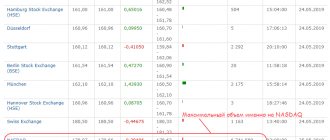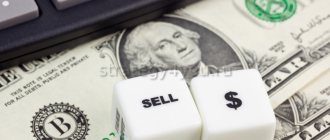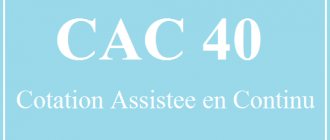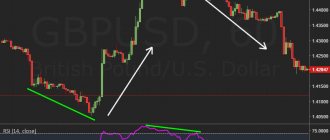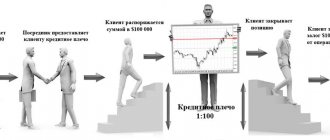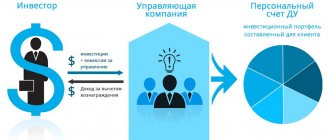Profitable trading depends not only on the knowledge gained and studying the market, but also on the factors that influence its operation. Of great importance is not only regular analysis of the state of the exchange, but also trading volumes on Forex. Even trading according to all the rules and strategies, many investors lose their money. This happens when large market makers appear on the Forex market and set their own conditions on the exchange.
Indicator: trading volume
Trading volume is a quantitative indicator reflecting the amount of trading turnover, for example, for the securities of a company. In other words, the trading volume (turnover) in this case will be the number of shares that participated in trading operations per unit of time (usually a business day).
The most convenient way to analyze trading volume is to present its dynamics in the form of a bar graph. Such work is an integral part of the general technical analysis of market trends and stock price dynamics.
Currency exchange (currency exchange) - what is it and how to conduct currency trading online in real time
In this material you will learn what a currency exchange is, who provides access to the currency exchange online and how currency trading is carried out in real time.
This publication is useful for those who plan to trade on the currency exchange, as well as for those who are interested in finance. If you fall into one of these categories, don't waste time, start reading right now.
So, what is a currency exchange?
A foreign exchange exchange is a platform on which the purchase and sale of monetary units of various countries is carried out. The currency exchange is often called Forex, but this is not entirely true. We wrote in detail about what Forex is and how to make money on it in previous articles.
Initially, the purpose of creating a currency exchange was to provide convenience for exchanging currencies. However, this task gradually faded into the background. Today, Forex is primarily used for the purpose of making profits by traders.
It is not possible to determine the exact turnover of the foreign exchange market. However, studies show that the average is more than $4 trillion.
A large number of bidders can be identified:
- • individuals;
- • investment funds;
- • central banks;
- • brokers.
Brokers act as intermediaries between the exchange and the trader. In the process of work, they execute trading orders, receiving a reward for this. The broker's commission is charged in the form of a spread. Spread is the difference between the purchase price and sale price of a currency.
The currency exchange operates 24 hours a day on weekdays. At the same time, many modern brokers allow you to simultaneously trade on the foreign exchange and stock exchanges. The latter deals with securities – stocks, bonds and their derivatives.
An important difference between the Forex market and the stock exchange is trading exclusively via the Internet. There is no special room for trading currencies. There are, of course, special sections on stock exchanges, for example, on Moscow. However, they are created only for the convenience of trading; currency prices are not formed here.
An important advantage of the Forex market is the special fluctuations in currency prices. They move relatively steadily. If unexpectedly sharp movements occur, prices most often return to a certain range within a certain period of time.
In the stock market, some instruments may become completely worthless. This happens during the collapse and bankruptcy of the companies that issued them.
Important! Due to the fact that sharp collapses in the foreign exchange market are much less common, it is easier to analyze than the stock market. The forecasts made turn out to be more accurate. And this is not the only difference between the stock and foreign exchange markets.
Forex attracts beginners due to the presence of leverage. When purchasing currency, the trader deposits only part of the funds into the account; the rest of the money is borrowed from the broker. The amount of funds received depends on the size of the leverage.
Leverage is a ratio that shows how much of a trader's own funds is used in a transaction, and how much he borrows from a broker.
In the stock market, high leverage is not used. Therefore, to trade you have to deposit a fairly large amount of funds. Don't forget that stock market instruments are quite expensive. This is especially true for the markets of Europe and America.
Main functions of a currency exchange
The functions of the currency exchange are determined by the fact that the uncontrolled activities of traders can lead to unpredictable effects.
We should not forget that imbalanced exchange rates provoke serious problems in the economies of various countries.
Below are the 4 main functions of a foreign exchange exchange.
1. Pricing
One of the most important functions of a foreign exchange exchange is pricing. Traditionally, price refers to the agreement between seller and buyer about the value of a particular product. On the currency exchange this definition is not absolutely reliable. The fact is that the exchange takes into account the opinions of not two participants in the transaction, but a huge number of people and organizations operating at a particular moment in the market.
Prices are not formed on their own, but are based on many different factors:
- • political and economic news;
- • military conflicts;
- • natural disasters;
- • market mood (that is, the majority of trading participants).
It is these factors that determine the degree of fluctuations, predictability and other important phenomena. The results of price formation are reflected in the charts. The result is an image that allows you to evaluate the change in the value of the instrument resulting from the influence of the market.
Traders who have been analyzing the market for many years can identify price trends. They are mainly influenced by the largest market participants. They are usually called majority shareholders, which include central banks, as well as the largest investment funds.
2. Calculation and adjustment of prices
If speculators are given free rein, they can collapse the exchange rate. Therefore, prices are controlled by Central Banks. As the main tool for influencing rates, they use intervention, which is understood as the purchase and sale of foreign currencies. Other tools are also used to adjust prices.
It is important to understand! In fact, traders benefit from Central Banks regulating exchange rates. Thanks to control, their fluctuations occur within a certain corridor.
At the same time, speculators have the opportunity to make good profits by concluding transactions in overbought and oversold areas. To determine these levels, traders use various indicators.
In some cases, the Central Bank may refuse to control the exchange rate of its currency. The result may be a sharp, unpredictable jump, which leads to losses for many traders.
EXAMPLE: This is exactly the situation that happened with the Swiss franc at the beginning of January 2015. Up to this point, the currency in question was quite stable. When the Swiss central bank stopped fixing its value, the rate changed dramatically.
In a short time, the value of the currency increased by 20% compared to major world currencies. Subsequently, it gradually returned to its previous level, but the stability of the Swiss franc, as well as the reputation of the Swiss central bank, was lost forever.
3. Organization of auctions
The foreign exchange exchange brings together participants in currency trading. Brokers and traders predominate among them. The former are engaged in creating favorable conditions for trading on the stock exchange. For this purpose, brokers provide speculators with special terminals that allow them to analyze the market and place orders, earning money.
4. Selection of trading participants
Only major market players can influence the value of currencies. However, with the development of the Internet, absolutely everyone has the opportunity to take part in trading. It is enough to open a special account and deposit a minimum amount into it.
But do not forget that beginners very often succumb to emotions. They are often overcome by greed or fear. The result is the loss of the deposit, the market forces out inexperienced traders in the course of natural selection.
The currency exchange is a rather complex economic organism. It performs important functions in the regulation of value, as well as the organization of currency trading.
Currency exchange instruments are currency pairs (for example, EUR/USD). Their name consists of two currencies (euro/dollar). To make money on the currency exchange, it is enough to open a buy position, expecting an increase in value, or a sell position, expecting it to decrease.
Naturally, most small traders do not know how to correctly predict the further movement of quotes on the market. They open trades when the trend is already actively developing.
Experts note that quite often a market reversal follows an active increase in the number of transactions in one direction. In other words, don't follow the crowd. If there is a change in the direction of movement of quotes, you can get a huge loss.
Many people believe that trading on the foreign exchange market is not difficult. This opinion was formed due to the fact that there are only 2 categories of currency transactions - purchase and sale.
But the main difficulty of trading lies in the inability of most traders to correctly determine the right moment to enter and exit the market. To trade successfully, you need to know techniques for predicting further price movements.
To select the time of purchase and sale, special methods are used, which are divided into 2 large groups:
1. fundamental analysis; 2. technical analysis.
Predicting price movements using fundamental analysis involves a thorough study of the economy as a whole.
Many traders use news trading. They analyze upcoming events in the economies of various countries and, based on them, make forecasts regarding changes in the value of currencies. Often unexpected developments lead to a sharp change in quotes.
During fundamental analysis, the following indicators are monitored:
- • inflation and unemployment levels;
- • GDP size;
- • key rates of Central banks.
It is important to keep in mind that fundamental analysis gives good results only over the long term.
Worth considering! Traders who trade for short periods do not carefully study the economic situation. It is more important for them to determine who is stronger in the market - bulls or bears. The former make a profit when the value of currencies rises, the latter – when they fall. Technical analysis helps determine the prevailing mood in the market.
Technical analysis requires a comprehensive study of the current market situation. Its purpose is to predict the future movement of quotes based on historical price data.
There are a huge number of technical analysis tools:
- • support and resistance levels;
- • trend lines;
- • various indicators;
- • Japanese candlestick patterns, etc.
A beginner, regardless of what time periods he plans to work on, should learn the basics of the two groups of analysis. However, in most cases, technical analysis is easier to understand.
What are the advantages of trading on the foreign exchange exchange - 4 main advantages
Most traders begin their acquaintance with stock trading with Forex, where the main instruments are currency pairs. This market has a number of advantages over the stock market.
Let's take a closer look at them.
1) Availability of leverage
In the Forex market, currencies are sold in so-called lots. This means that you cannot make a transaction with multiple monetary units.
The size of one lot is 1,000 units, so any transaction must be a multiple of one thousand. Naturally, not all individuals have the opportunity to deposit into their account an amount sufficient to purchase at least one currency lot.
Leverage helps solve the problem. It is a ratio that shows how much of his own funds the trader uses in a transaction, and how much he borrows from the broker.
The maximum leverage value usually does not exceed 1:500. Experts do not recommend trading with a leverage of more than 1:100.
On the one hand, leverage allows you to earn more by using in trading an amount that exceeds what the trader has available. However, we should not forget that this also increases the riskiness of trading.
EXAMPLE: So, if the leverage is set at 1:10, and the trader opens a trade using all his funds, a drop of 10% will lead to a complete loss of the deposit.
2) Possibility of remote trading
Stock exchanges initially operated on the floor; much later they began to operate online. At the same time, Forex was immediately created as a market operating via the Internet.
There is no need to leave your home to trade currencies. It is enough to install a special program on your computer or any mobile device, which is called a trading terminal. After this, you need to carry out an analysis and you can open a deal.
Not only trading is carried out via the Internet in Forex. You can also receive news online and study analytics.
3) 24/7 trading
Trading in the stock market is carried out in sessions; the exchange is closed at night. In contrast, the currency exchange operates 24 hours a day. The market closes only on weekends. Even during a break in the operation of the currency exchange, the exchange rates of currency pairs change.
Often after a weekend, under the influence of serious events, traders observe a break in the rate of a currency pair. This situation is called a gap. However, it occurs less frequently than on the stock exchange. This is due to the fact that Forex is closed only on weekends and holidays.
On some days, trading on a specific instrument is not carried out, since the pair includes a currency where a national holiday occurs.
4) Source of additional income
Some traders use short-term time intervals in trading. They monitor the market on time frames that are several minutes long.
Traders who make money on the slightest price changes are called scalpers, and the strategies they use are called scalping. Such speculators are forced to spend a lot of time near the computer.
Not everyone has the desire to devote a huge amount of time to trading. The currency exchange allows you to trade with minimal costs. This can be achieved by working with medium to long term time frames. Such trading can be a great opportunity to earn extra money.
Thus, Forex has a number of advantages over the stock exchange. Experts recommend that novice traders work in the foreign exchange market.
How to trade on an online currency exchange - 5 main stages
Many beginners, when deciding to start trading, do not know where to start. It is worth understanding that you will not be able to achieve stunning success right away.
However, there is a way to speed up the infusion into the process - just use instructions from professionals. It describes the stages that a trader will have to overcome at first in order to achieve success.
Stage 1. Choosing a broker
It is important to take the choice of a brokerage company as seriously as possible. If a trader opens an account with a fraudster, he will almost completely end up without money.
Today there are a large number of reliable brokerage companies operating in Russia. To choose the best broker, you need to take into account not only favorable rates, but also its other characteristics.
When choosing a brokerage company, you should pay attention to the following points:
- • period of work on the market;
- • reputation;
- • availability of a license;
- • insurance guarantees;
- • reviews.
By the way, on our website there is a separate material where the rating of Forex brokers is presented - we recommend that you familiarize yourself with it.
Stage 2. Opening a trading account
Usually, beginners easily open a trading account, since this procedure is quite simple and understandable to everyone.
To open a trading account, you just need to do a few steps:
1. registration of a personal account; 2. filling out a short questionnaire; 3. transfer of funds to the deposit.
Each broker independently sets the minimum amount with which you can start trading.
Stage 3. Analysis of the market situation
Once the account is opened and funds are deposited into it, the trader can begin trading. Important to consider! You should not immediately open a deal based solely on intuition. This can only be done when working with binary options.
When concluding transactions to buy or sell currency, you should rely on the results of the analysis. Most reliable brokers provide special classes on fundamental and technical analysis techniques. Most often they are absolutely free.
Stage 4. Development of a trading strategy
Some advertisements claim that they can offer beginners the optimal strategy that will bring huge income always and on any financial instrument. You should not believe this, such trading plans (strategies) do not exist.
A trading strategy involves developing rules for entering and exiting the market. It is important to decide which method will be used to determine when to open trades. In addition, the strategy obliges you to establish under what conditions to record profits and losses.
The next step is to check your trading strategy. This can be done using historical data on the value of currency pairs. There is another option - a demo account. Most modern brokers offer them. This account allows you to check the performance of your trading strategy without risking real money.
It is also important at this step to assess the possible level of risk. To do this, it is assumed that the market went in the direction opposite to the trader’s expectations and did not return back.
It is important that the loss on one transaction does not exceed 2% of the deposit amount. If this rule is violated, the risk of complete drainage of funds from the account increases significantly.
Stage 5. Start of trading
Only after the trading strategy has been developed and tested can you begin trading online. In principle, there are usually no difficulties with this.
First of all, you should select the transaction volume. Next, if the trader expects further growth, he purchases a currency pair by clicking the Buy button. If the speculator expects the exchange rate to fall, he sells the currency by clicking Sell.
In the trading process, it is important to abandon emotions as much as possible. You should not deviate from the developed trading rules and make transactions under the influence of intuition alone.
By the way, you can trade not only ordinary currency pairs, but also various types of raw materials, as well as cryptocurrencies. Moreover, it is much easier to carry out transactions in cryptocurrencies; as a rule, there is a trend here. The main thing is to find a trusted broker, one of which is RoboForex.
By strictly adhering to the plan described above, even a novice trader can start trading. It is only important to treat this as a job without risking your own money.
Don’t forget that an exchange is not a casino, so trading only on the basis of intuition inevitably leads to losing your deposit.
Who provides access to online currency trading
Sometimes choosing a good broker can be difficult due to the presence of a huge number of companies on the Russian financial market. Advice from experts who compile reviews of the best brokerage companies helps you make the right decision. Here is one such review.
When choosing a broker, experts advise beginners to refer to ratings from professionals. In this case, you will not have to analyze a huge number of characteristics for all companies. It is enough to study the description of brokers and choose the right one. —————————————————————————————————-
How to succeed in the foreign exchange market
We invite you to take note of a few simple but extremely important tips. They will help not only not to lose money, but also to become a real trading professional.
Tip 1. Use the services of experienced brokers
There are several simple tips for choosing the right broker; read about them in the article “Best Forex”. No matter how tempting the offers of young intermediaries may seem, they have not been tested by time, it is better not to take risks.
Almost all of the brokerage companies listed in the article have been operating on the market almost since its appearance in the Russian Federation, so they have proven their reliability one hundred percent.
Tip 2. Take trading training courses
First, read the basic course, then learn to work in the trading platform. Once this fundamental knowledge has been obtained, move on to studying trading strategies.
Try different areas of technical analysis: they will teach you to correctly understand the market. After mastering other people's strategies, learn to synthesize them, forming your own.
Learning to trade is the most important stage in the development of a professional stock exchange player. Without this, significant earnings in the foreign exchange market are simply impossible.
Tip 3. Control your profits
In other words, follow your trading plan. If you have carried out an analysis and concluded that the price should rise to a certain level, place Take Profit and Stop Loss orders and wait.
Closing a trade early with a profit, exiting the market with a small loss before the Stop Loss is touched is a violation of the trading plan. Sooner or later you will completely merge if you don’t think about discipline.
Why is trading volume needed?
Today traders use several dozen indicators that, to one degree or another, take into account trading volume. Why is this indicator given so much attention? First of all, specialists are interested not so much in the value of volume or turnover itself, but in its dynamics, the magnitude of this change, as well as comparison of the direction and extent of these changes with price charts. For example, a systematically increasing volume with rising prices will indicate a stable upward trend. At the same time, any discrepancy may indicate possible changes in the price and direction of the trend as a whole.
Market exhaustion
As you can see, the price declined on heavy volume but settled below the previous support point. After this surge in volume, the price began to move up.
This is an example of a fairly long downtrend followed by an underlying pattern and an increase in volume. An increase in volume could be a sign that accumulation is occurring. Soon after, the price rose sharply.
Trading volumes on the MICEX: examples
Current trading volumes in monetary and unit terms are published daily on the official websites of exchanges. For example, on one of the June days of 2015, trading volumes on the MICEX for the most traded securities amounted to:
- Sberbank of Russia – 5809055665 rub. or 84780130 pcs.
- LUKOIL – 2544506523 rub. or 1029639 pcs.
- NorNickel GMK – 1796243890 rub. or 197824 pcs.
- Rosneft – 1269060148 rub. or 5694430 pcs.
- MMK – 1173412083 rub. or 69065100 pcs.
- Magnet – 1055976216 rub. or 96506 pcs.
- Surgutneftegaz – 937019052 rub. or 23096500 pcs.
- VTB Bank – 805426657 rub. or 10950740000 pcs.
- Severstal – 612962220 rub. or 1050350 pcs.
Gazprom – 3216256340 rub. or 22499230 pcs.
For comparison, the average daily volume of securities trading on the MICEX in June amounted to 33.6 billion rubles. The average daily trading volume of the Moscow Exchange currency market is 1326.9 billion rubles ($24.4 billion), and the average daily volume of monetary transactions is 834.8 billion rubles.
Description of Better Volume indicator signals
Improved tick volume indicator Better Volume automatically evaluates the current volume and spread of the candle, comparing them with previous values, and gives us some kind of signals indicating the presence of high/low volume and the size of the spread. Here is a list of color signals that appear in the Better Volume histogram.
Red color means there is high volume and a wide spread on the up bar. Appears at the beginning and end of uptrends, as well as during corrections during a downtrend.
White color means high volume and wide spread on the down bar. Appears at the beginning and end of bearish trends, as well as during corrections during an uptrend.
Yellow color means low volume. Appears at the end of trends, as well as during corrections.
Green color – indicates the presence of a bar with a small spread and significant volume. Appears at the end of trends (transfer of assets from market makers to ordinary traders) and during profit taking in the middle of trends.
Trading charts on the MICEX
This is what the graph of trading volume in Sberbank shares on the MICEX looks like over several months of 2015:
In this case, the dynamics of the value of securities is compared with the volume of trading in shares, which allows for a more in-depth technical analysis.
As for the foreign exchange market, this graph perfectly shows how the volume of currency trading and its value are interconnected:
Tweet
See also: Gazprom shares Price of AvtoVAZ shares today Stock quotes
Lower timeframes
Based on those previous examples, volume in forex can be a pretty useful predictor of future price movement. But wait a minute, those were some well-chosen examples. What happens if you choose a different time slot? For example, a 4-hour chart? Here's what you'll see.
Differences in market opening times and volume are reflected in intraday volume spikes. However, if you only take spades, it will be usable.
